Don’t Get Robbed (By The BANKS)!

Traveling & expat living should not be marred by silly issues & hidden financial traps. BUT from the slick lure of Dynamic Currency Conversion (DCC) which tricks travelers into accepting inflated exchange rates and HUGE fees, to ATMs that quietly tack on outrageous withdrawal costs or decide to keep your card, the financial landscape abroad can be riddled with costly surprises – time & money wise. Awareness is your first line of defense—and knowing how these near-scams & unfortunate accidents work is the key to keeping your balances healthy. Let’s dive into this murky world!

💰🔫 Dynamic Currency Conversion: The Silent Heist Targeting Tourists
Imagine this: you’re in Costa Rica, sipping fresh coconut water, ready to pay for your jungle tour. The card reader flashes two options—pay in Costa Rican Colones or in your home currency. You choose the familiar one. The Canadian Dollar. US Dollar. The Euro. And just like that, you’ve been overcharged via a silent conversion fee. Sometimes, by 10% or more. So withdrawing $500 worth of Colones can cost you $50 in needless fees. A fancy $200 family dinner will cost you $20 in useless fees. You are tipping the financial companies for NOTHING! Yes – you get ZERO benefit out of it except being shown the transaction amount in your home currency. And, to put salt on the wound, you are also likely to get a poorer exchange rate as well!
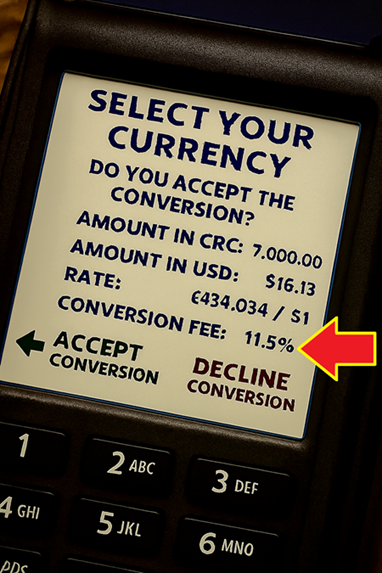
Welcome to the world of Dynamic Currency Conversion (DCC)—a “service” that’s marketed as helpful but often functions like a legal scam. It is offered at point-of-sale terminals, ATMs, and during online shopping experiences.
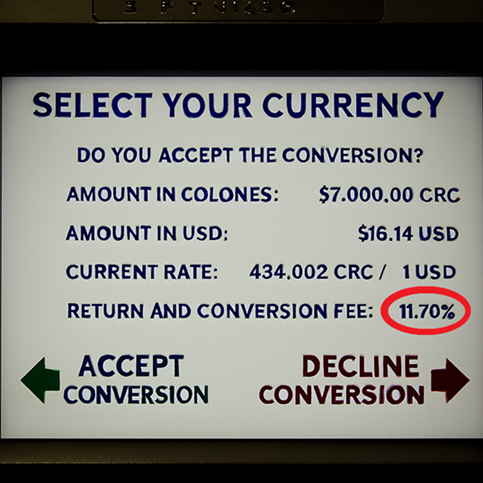
– How the DCC Robs You 🕵️
- DCC Exchange Rates – DCC exchange rates can be 3–10% worse than your bank’s standard rate. That’s money lost on every transaction.
- DCC Fees – The DCC fees can be as ridiculous as the exchange rates – 10% or more, in cases. Familiarity feels safe, but it’s costly.
- The Fees and Exchange Rates Can Be Hidden – You’re shown the amount in your currency, but not the ‘DCC fee’ and ‘DCC exchange rate’ markups. They may be there on the screen, in fine print, off to the side, at the very bottom, or completely hidden. Often you will see an asterisk that is there for plausible deniability – after all, will you read the fine print when withdrawing cash at an ATM? It’s psychological trickery: familiarity feels safe, but it’s costly.
- Merchants Profit from Your Confusion – Many terminals default to DCC or make it hard to opt out. I’ve seen stores where placards advertise the DCC right next to the payment terminals. Some travelers don’t even realize they’ve agreed to it. Think about all the times you used touchless payment and the clerk tapped a button on the terminal. Do you know what they did?
- Triple Trouble – If your card charges foreign transaction fees, you might pay those on top of the DCC fees & the terrible DCC exchange rates. That’s a triple hit. Yikes!

– How to Protect Yourself 🛡️
- ALWAYS DECLINE the DCC offer and choose to pay in the local currency—whether at ATMs, shops, restaurants or online. You can peek at the DCC amount to see the approximate value of your transition in your home currency – that is all you need as in all likelihood, your the actual transaction value will be less as it will not include the fee and exchange markup.
- Watch the screen carefully—some terminals & ATMs sneak in the DCC unless you actively reject it.
- Use cards that waive foreign transaction fees, like Wise or Revolut.
- Report shady practices to your bank or card provider.
- Stay alert, choose local currency, and treat every payment screen like a potential trap.
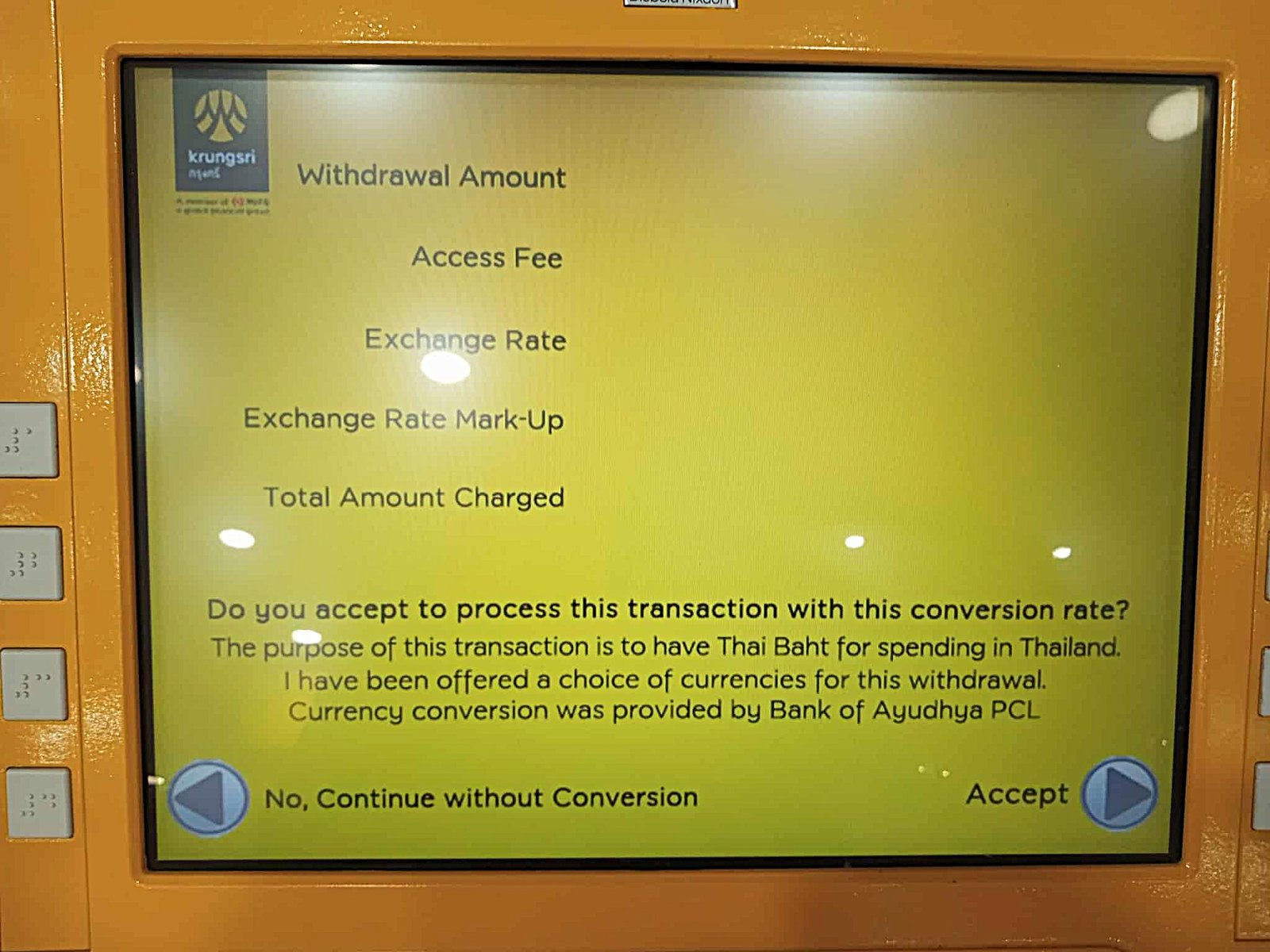
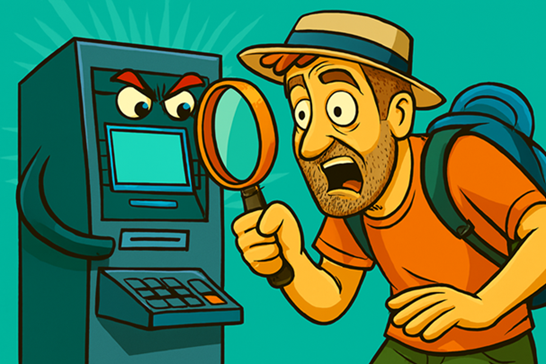
💸 🔫 The ATM Fee Trap: What Tourists Need to Know
I made my way to the San Jose bus station, card in hand – 7,000 Colones ($14USD) would take me all the way to Uvita. But not so fast – I am promptly informed this is a CASH ONLY bus station. And just having gotten off the plane the night before – and not bothered to visit a reasonable ATM – I am stuck. My fault, and now I need Colones. Only one ATM was near and, long story short, it charged me 7,000 Colones just to access my money. The same amount as the bus ticket!

Costa Rica may be a paradise of volcanoes, wildlife, and Pura Vida vibes—but for tourists relying on cash, it can also be a minefield of hidden ATM fees. This is true of all countries, so I am not picking on Costa Rica! While Costa Rica’s banking infrastructure is generally reliable, many visitors are shocked to discover how much they’re paying just to access their own money.
– How to Minimize ATM use fees 🛡️
- Withdraw larger amounts less frequently to reduce per-transaction fees.
- Use bank-affiliated ATMs, preferably inside branches or malls.
- Avoid airport, resort, and white-label ATMs, which often have inflated fees.
- Bring some cash from home, especially if you have access to USD. BUT if you choose to survive without local currency, ALWAYS make sure merchants accept USD or bank card payment.
- Research fees offered by different local banks to find the best deal. but know that the fees often change and online info may not be up to date or accurate.
- Use credit cards / bank cards for purchases whenever possible to avoid cash withdrawals. Many such cards offer great exchange rates and minimal or zero fees.

💳🍽️ THE EATEN BANK CARD
Ah yes—the dreaded moment when your ATM card vanishes into the machine, not to be seen again – or for a LONG time. In Costa Rica, this isn’t just a rare glitch—it’s a real risk, especially for tourists unfamiliar with local banking quirks. Here’s how it happens, why it matters, and what to do if your card gets “eaten.”
– Why ATMs in Costa Rica Swallow Cards 🏦
- Timeouts and Software Glitches – If you pause too long between steps—say, while translating the screen or checking fees—the machine may time out and retain your card.
- Security Protocols – Some ATMs automatically retain cards if they suspect fraud, if the card is damaged, or if the PIN is entered incorrectly too many times.
- Power Failures or Reboots – Machines can suddenly restart mid-transaction, especially in remote areas or during storms. When this happens, the card may be trapped inside.
- Foreign Card Rejection – Not all Costa Rican ATMs play nicely with international cards. If the machine can’t verify your card, it may retain it without warning.

– What to Do If Your Card Gets Swallowed🛡️
- Wait 10–15 Minutes: Sometimes the machine reboots and spits the card back out.
- Note the Time and Location: Record the ATM’s details, including bank name and any reference numbers. Get in touch by using any phone numbers or company ID on the machine. You may also ask any nearby businesses if they know which company or bank are responsible for the machine.
- Visit the Bank (with your Passport): If the ATM is attached to a bank, go inside with your passport. Some banks will return the card fairly quickly after verifying your identity.
- Freeze the Card Immediately: Use your banking app to block the card to prevent misuse.
- Use a Backup Card: Always travel with at least two cards—one for use, one for emergencies.
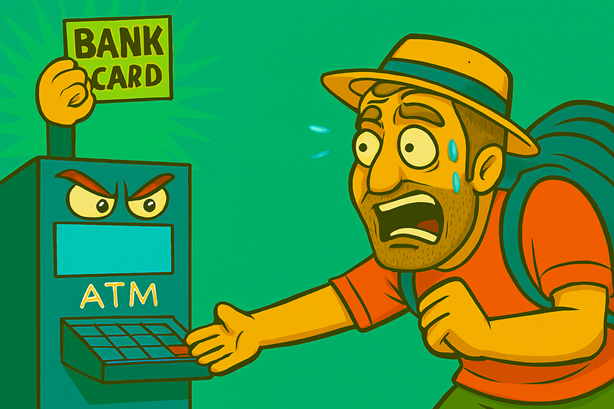
– Pro Tips to Avoid the Card-Chomp ✈️
- Use ATMs inside bank branches, preferably during business hours.
- Use branded bank ATMs. Avoid ‘white label’ ATMs – it may be hard to track down owners & resolution.
- Avoid withdrawing cash late at night or from isolated machines where help can be a far-way off.
- Carry a copy of your passport in case you need to retrieve a swallowed card.
- Consider travel-friendly cards like Wise or Revolut, which offer quick replacements and app-based freezing.
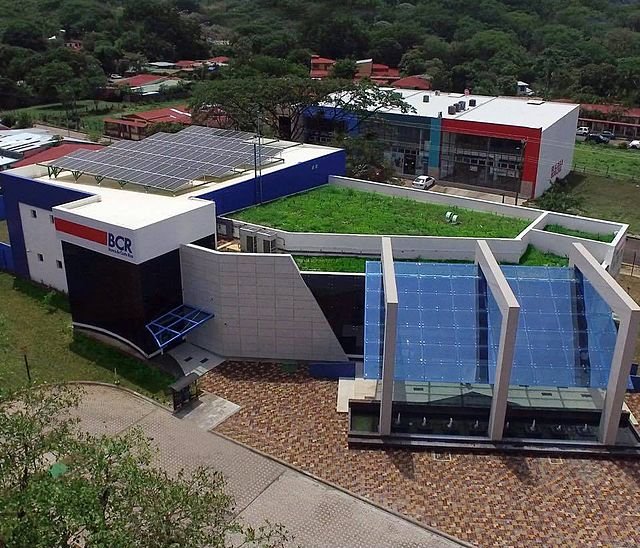
Using ATMs inside local banks is the best way to access your cash – you know you will get help if your card is swallowed AND there is a much lesser chance the machine has been compromised by thieves. This is a BCR branch in Nicoya. c/0 Luciuskam, wikicommons. A beautiful, thrilling, chilled-out land with surprises around every corner! With a bit of local knowledge, you’ll fit right in – could you picture yourself making Costa Rica home? We invite you to browse the local properties available in our area, knowing that RE/MAX WE SELL PARADISE is your trusted partner in the South Pacific corner of Costa Rica.



